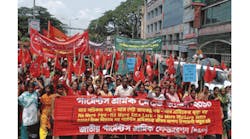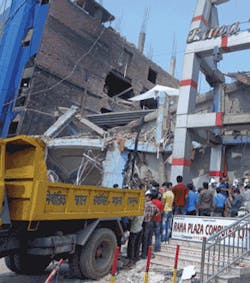Have these programs failed because apparel corporations were unaware of the dangers in Bangladesh? Clearly not; apparel brands and retailers have been aware of the risks facing apparel workers in Bangladesh, both from fires and building collapses, for many years. In 2005 and 2006, for example, two building collapses and four fires took the lives of more than 200 workers, including an infamous building collapse at a factory called Spectrum Sweater in which 64 died. At the time, the depth of the problem was widely acknowledged by brands and retailers, factory owners and the Bangladesh government, and vigorous reforms were promised.
Have these programs failed because brands and retailers don't understand what steps are necessary to make factories in Bangladesh safe? The answer, obviously, is no. Since the aftermath of the Triangle Shirtwaist fire, the fundamentals of fire and building safety in an industrial setting have been well understood by the apparel industry.
Are these programs failing because of subcontracting of orders, with Bangladeshi suppliers evading the brands' inspection efforts by sending part of their work out to unauthorized factories that escape scrutiny? This explanation is a popular one with apparel brands and retailers, since it allows them to deny direct responsibility, but the facts show otherwise. With one exception, every one of the factory buildings in which workers have died in fires and collapses in Bangladesh since 2010 had been repeatedly inspected by industry monitors. These were not subcontract factories flying beneath the industry's radar.
Page 2...continued
Is the failure of industry inspection programs to protect workers from fires and building collapses the product of an earnest effort marred by poor execution? There certainly are plenty of incompetent factory auditors; however, this explanation fails because these auditors, incompetent or otherwise, were never even asked to look at the most important safety issues. It has become clear in the wake of the Tazreen Fashions fire in November 2012 and this April's Rana Plaza building collapse that standard industry inspections do not include any review of the structural integrity of factory buildings nor any assessment of whether buildings have properly designed fire exits, despite the fact that lack of emergency egress and structural failures are by far the two largest causal factors in apparel worker deaths.
• They did not cost much, because fire-safety responsibilities were left in the hands of generalist auditors, carrying out inspections covering dozens of labor issues, rather than tasked to qualified fire-safety experts conducting comprehensive (and much more expensive) fire-safety inspections. Nor was there any role for structural engineers and their expensive techniques and equipment.
• They did not conflict with the brands' and retailers' overarching imperative of keeping production costs to a bare minimum – because the inspectors never raised any concerns about how pressure on factories to slash production costs encourages cutting corners on safety and because, with structural issues such as proper exit stairs ignored as a matter of policy, brands and retailers were never called on by the inspectors to help factories pay for the costly renovations necessary to make buildings safe.
• They did not cause embarrassment – because even when the inspectors found problems – like missing fire extinguishers or blocked exits – the reports were controlled by the brands and retailers and never revealed to the public.
The credibility of these longstanding industry inspection schemes collapsed on April 24, 2013, buried with a thousand workers in the rubble of Rana Plaza.
Many brands and retailers, to their credit, have responded by embracing a fundamentally new approach: the Accord on Fire and Building Safety in Bangladesh. The accord is a labor-management agreement under which companies have made a binding commitment to allow thorough, independent fire- and building-safety inspections by qualified experts, with public reports, and to help pay for the building repairs, renovations and retrofitting necessary to transform death traps in Bangladesh into safe factories.
Unfortunately, some major industry players in the United States, such as Walmart and Gap, are clinging to the past. They refuse to sign the accord and have instead offered in response to Tazreen and Rana Plaza a dressed-up version of the same audit schemes that failed to prevent those disasters.
There are more than 2 million workers in factories covered by the accord and, if the agreement is implemented effectively, the risks to their lives and safety soon will diminish. Sadly, there are hundreds of thousands of workers producing for Walmart, Gap, VF Corp. and other buyers that continue to prioritize cheap clothes over the protection of human life.
Scott Nova is executive director of the Worker Rights Consortium (WRC). WRC is an independent labor-rights monitoring organization that conducts investigations of working conditions in factories around the globe.


